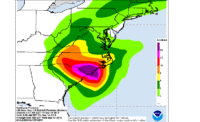When companies take work to the ends of the earth, communication reliability goes out the window, especially in areas struck by wars or disasters. For professionals determined to maintain contact, whatever the conditions, satellite data terminals are the ultimate backup plan.

On a recent reporting trip to Haiti, I packed a BGAN Explorer 500 Satellite Data Terminal from Inmarsat. It was on loan to ENR so I could test it for business continuity. GIT Satellite Communications, Austin, Texas, provided support. My intent was to maintain connectivity, whatever the conditions, just as firms deploying for reconstruction in Haiti—or anywhere else—might need to do.
ENR editors have used earlier models of Inmarsat terminals from Europe, Iraq and Afghanistan and have found them great for e-mail, sending attached files and web-browsing. But the intent in Haiti was to maintain more intensive processes, such as checking page layouts in and out of a server and posting-high resolution video.
The BGAN has an on-board battery that can run for a few hours of heavy use, but I also took an Xpal rechargeable Energizer power pack with multiple outputs. Generally, in Haiti, I was able to get 110-volt AC power and sometimes even Internet service. But blackouts and unpredictable generators often shut me down. Then the BGAN went to work.
The 3.1-lb terminal needs a view of the satellite, but it also shoots through foliage, tents and the fiberglass tops of HUMVEEs. Software loaded in advance, an on-board compass, tilt vernier and GPS, help set altitude and azimuth for one of the three Inmarsat geo-stationary satellites that cover nearly the entire earth. Alternately, users can aim by listening to a beep that starts when the modem is pointed in the general direction of a satellite. Rotating the unit and moving the folding leg under the back adjusts the aim. The beeps get faster as you zero in, becoming a solid tone with a hit.
In Haiti, e-mail and browsers worked well, but operations with lots of overhead or ones requiring “handshakes,” struggled or timed out.
Gurudain Chana, an Inmarsat technologist in London, later explained that heavy traffic from the region was a problem. Also, while the maximum bandwidth is 492 kbps, signal latency is “a lot longer” via satellite, and it adds up, leading to time-outs. Software overhead on some VPN products use as much as 85% of available bandwidth, with some FTP products being nearly as bad, slowing uploads to a crawl. Chana says getting software vendors to reveal overhead is almost impossible, but by testing and timing transmission of the same packet through different systems you can find the best alternatives. Up-front planning of all usage strategy is important, Inmarsat suggests, before attempting to communicate from far afield.



Post a comment to this article
Report Abusive Comment